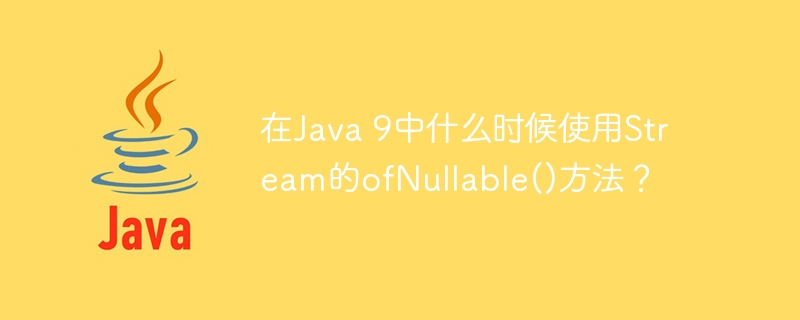Example 1" >Syntax H2>static <T> Stream<T> ofNullable(T t)
Copy after loginExample 1
static <T> Stream<T> ofNullable(T t)
When to use ofNullable() method of Stream in Java 9?

ofNullable() method is a static method of the Stream class. If it is not empty, it returns a sequential Stream containing a single element. , otherwise it returns empty. Java 9 This method was introduced to avoid NullPointerExceptions and avoid null checks for streams. The main goal of using the ofNullable() method is to return an null option when the value is null.
Syntax H2><strong>static <T> Stream<T> ofNullable(T t)</strong>
Copy after loginExample 1
import java.util.stream.Stream;
public class OfNullableMethodTest1 {
public static void main(String args[]) {
System.out.println("TutorialsPoint");
int count = (int) Stream.<strong>ofNullable</strong>(5000).count();
System.out.println(count);
System.out.println("Tutorix");
count = (int) Stream.<strong>ofNullable</strong>(null).count();
System.out.println(count);
}
}Copy after loginOutput
<strong>TutorialsPoint
1
Tutorix
0</strong>
Copy after loginExample 2
import java.util.stream.Stream;
public class OfNullableMethodTest2 {
public static void main(String args[]) {
String str = null;
Stream.<strong>ofNullable</strong>(str).forEach(System.out::println); <strong>// prints nothing in the console</strong>
str = "TutorialsPoint";
Stream.<strong>ofNullable</strong>(str).forEach(System.out::println); <strong>// prints TutorialsPoint</strong>
}
}Copy after loginOutput
<strong>TutorialsPoint</strong>
Copy after login
<strong>static <T> Stream<T> ofNullable(T t)</strong>
import java.util.stream.Stream;
public class OfNullableMethodTest1 {
public static void main(String args[]) {
System.out.println("TutorialsPoint");
int count = (int) Stream.<strong>ofNullable</strong>(5000).count();
System.out.println(count);
System.out.println("Tutorix");
count = (int) Stream.<strong>ofNullable</strong>(null).count();
System.out.println(count);
}
}<strong>TutorialsPoint 1 Tutorix 0</strong>
import java.util.stream.Stream;
public class OfNullableMethodTest2 {
public static void main(String args[]) {
String str = null;
Stream.<strong>ofNullable</strong>(str).forEach(System.out::println); <strong>// prints nothing in the console</strong>
str = "TutorialsPoint";
Stream.<strong>ofNullable</strong>(str).forEach(System.out::println); <strong>// prints TutorialsPoint</strong>
}
}<strong>TutorialsPoint</strong>
The above is the detailed content of When to use ofNullable() method of Stream in Java 9?. For more information, please follow other related articles on the PHP Chinese website!

Hot AI Tools

Undresser.AI Undress
AI-powered app for creating realistic nude photos

AI Clothes Remover
Online AI tool for removing clothes from photos.

Undress AI Tool
Undress images for free

Clothoff.io
AI clothes remover

AI Hentai Generator
Generate AI Hentai for free.

Hot Article

Hot Tools

Notepad++7.3.1
Easy-to-use and free code editor

SublimeText3 Chinese version
Chinese version, very easy to use

Zend Studio 13.0.1
Powerful PHP integrated development environment

Dreamweaver CS6
Visual web development tools

SublimeText3 Mac version
God-level code editing software (SublimeText3)

Hot Topics
 1378
1378
 52
52
 How does Java's classloading mechanism work, including different classloaders and their delegation models?
Mar 17, 2025 pm 05:35 PM
How does Java's classloading mechanism work, including different classloaders and their delegation models?
Mar 17, 2025 pm 05:35 PM
Java's classloading involves loading, linking, and initializing classes using a hierarchical system with Bootstrap, Extension, and Application classloaders. The parent delegation model ensures core classes are loaded first, affecting custom class loa
 How do I implement multi-level caching in Java applications using libraries like Caffeine or Guava Cache?
Mar 17, 2025 pm 05:44 PM
How do I implement multi-level caching in Java applications using libraries like Caffeine or Guava Cache?
Mar 17, 2025 pm 05:44 PM
The article discusses implementing multi-level caching in Java using Caffeine and Guava Cache to enhance application performance. It covers setup, integration, and performance benefits, along with configuration and eviction policy management best pra
 How can I use JPA (Java Persistence API) for object-relational mapping with advanced features like caching and lazy loading?
Mar 17, 2025 pm 05:43 PM
How can I use JPA (Java Persistence API) for object-relational mapping with advanced features like caching and lazy loading?
Mar 17, 2025 pm 05:43 PM
The article discusses using JPA for object-relational mapping with advanced features like caching and lazy loading. It covers setup, entity mapping, and best practices for optimizing performance while highlighting potential pitfalls.[159 characters]
 How do I use Maven or Gradle for advanced Java project management, build automation, and dependency resolution?
Mar 17, 2025 pm 05:46 PM
How do I use Maven or Gradle for advanced Java project management, build automation, and dependency resolution?
Mar 17, 2025 pm 05:46 PM
The article discusses using Maven and Gradle for Java project management, build automation, and dependency resolution, comparing their approaches and optimization strategies.
 How do I create and use custom Java libraries (JAR files) with proper versioning and dependency management?
Mar 17, 2025 pm 05:45 PM
How do I create and use custom Java libraries (JAR files) with proper versioning and dependency management?
Mar 17, 2025 pm 05:45 PM
The article discusses creating and using custom Java libraries (JAR files) with proper versioning and dependency management, using tools like Maven and Gradle.




